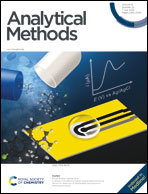Paper-based colorimetric sensor array for the rapid and on-site discrimination of green tea samples based on the flavonoid composition†
Abstract
Green tea is a worldwide appreciated food product with Chinese production estimated to reach over 3m tons in 2027 and with many valuable health effects. The development of analytical methods to discriminate among green tea samples is induced by economic benefits and to avoid deliberate origin mislabeling and adulteration. In this study, we present a paper-based colorimetric sensor array comprised of six ordinary reagents tailored for the discrimination of green tea extracts of different brands according to differences in the composition of flavonoids. The colorimetric array was rationally designed based on indicators that differentially react with a variety of flavonoids via specific functional groups. 4 μL of each reagent was impregnated onto the paper surface followed by the addition of the green tea extract. After 1 minute, digital images were acquired using a smartphone and the color changes were employed to build differential maps with a unique fingerprint for each green tea sample. Moreover, principal component analysis (PCA) and hierarchical component analysis (HCA) were employed to successfully discriminate among the samples, enabling the origin and adulteration identification of the samples. Therefore, this study provides a simple, effective, low-cost, and portable method for quick discrimination and quality control of green tea samples.

- This article is part of the themed collection: ENQA - 20th Brazilian Meeting on Analytical Chemistry


 Please wait while we load your content...
Please wait while we load your content...